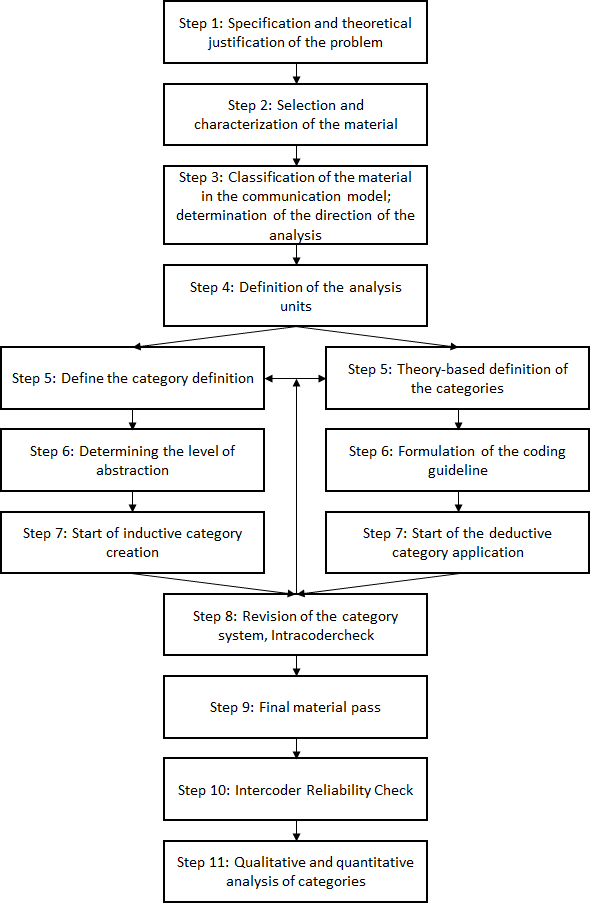General
The coding is part of the qualitative Content Analysis. In this analysis, rules are formulated in advance (process models, analysis units, content analysis rules), according to which the text analysis is performed. The rules are revised during the analysis but remain constant for the final passage of material. Text analysis is performed using categories. Categories represent the evaluation aspects and are similar to the codes in the Grounded Theory methodology (see also Grounded Theory), but they must be precisely defined in the content analysis. In Qualitative Content Analysis, the data material can be evaluated inductively, deductively, or inductively-deductively. Inductive means that the categories used are derived from the material. In deductive coding, on the other hand, the categories are derived from one or more theories. With the mixed form of inductive-deductive coding, both forms of categories are used. [1]
Goal
The aim of this method is to qualitatively analyze the content of text material in order to draw conclusions and findings. [1] The application of a systematic and methodical approach ensures the objectivity and traceability of the analysis, which is of crucial importance in scientific research.
Execution
Figure 1 shows the process of a qualitative content analysis. [1]

Table 1 shows examples of inductive categories from research diaries. [2]
|
Main Category |
Category |
|
Improvement of infrastructure and general work improvements (project improvements) |
Improvement of basic infrastructure |
|
Improvement of infrastructure and general work improvements (project improvements) |
Improvement of hardware equipment for specific requirements |
|
Improvement of the product (product improvements) |
Improvement of the product in general |
|
Improvement of the product (product improvements) |
Improvement of the product through testing |
|
Process optimizations |
Improvement of research diaries |
Table 2 shows examples of deductive categories from a digitization study. [2]
|
Category name |
Coding rules |
Reference of the theory |
|
Exploitative |
· Identifying existing customers · Assessing and understanding customer needs and expectations · Increasing process control and reliability · Intra-functional problem-solving · Training on existing skills |
(March 1991; Zhang, Linderman, and Schroeder 2012) |
|
Explorative |
· Identifying new customers and new customer needs · Involving customers in product development · Exploring new products and processes · Dynamic changes to the organisation · Cross-functional problem-solving · Training on multiple and new skills |
(March 1991; Zhang, Linderman, and Schroeder 2012) |
|
Process level |
· Refers to digital tools in solving tasks and activities |
(Parviainen et al. 2017) |
|
Organisation level |
· Refers to digitalisation initiatives facilitating the improvement of existing customer offerings · Refers to digitalisation initiatives facilitating the development of new customer offering |
(Parviainen et al. 2017) |
|
Business domain level |
· Refers to digitalisation initiatives facilitating the improvement of existing business models and value chains · Refers to digitalisation initiatives facilitating the development of new business models and value chains |
(Parviainen et al. 2017) |
|
Mandate (follower/leader) |
· Refers to QM as leading digitalization initiatives · Refers to QM as following digitalization initiatives |
|
|
Provider sphere |
· Refers to digitalisation initiatives developing and facilitating value in internal processes |
(Grönroos 2008, 2011) |
|
Interaction sphere |
· Refers to digitalisation initiatives developing and facilitating value together with customers |
(Grönroos 2008, 2011) |
|
Customer sphere |
· Refers to digitalisation initiatives in gathering information on customer behaviour, needs, and wishes · Refers to digitalisation initiatives in understanding customer value-in-us |
(Grönroos 2008, 2011) |
Core Literature
- [1] Mayring, P. (2010). Qualitative Inhaltsanalyse. In Handbuch qualitative Forschung in der Psychologie (pp. 601-613). VS Verlag für Sozialwissenschaften.
- [2] Elg, M., Birch-Jensen, A., Gremyr, I., Martin, J., & Melin, U. (2020). Digitalisation and quality management: problems and prospects. Production Planning & Control, 1-14.

